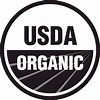Certified Organic WS404 BMR Forage Sorghum Hybrid

Certified Organic WS404 BMR Forage Sorghum is a high yielding, sterile sweet forage sorghum with reduced lignin content resulting in better digestibility, improved weight gains and higher milk production.
Sterile forage sorghums like WS404 have a high sugar content (18-21%) when grown to maturity and requires less inputs and water than corn for same production, thus the sugar stays in the stalk instead of being used to produce grain.
WS404 is an excellent dryland option for grazing, sileage or haylage.
Certified Organic WS404 Forage Sorghum can be harvested once for hay, baleage or silage at the heading stage or (80-85 days).
Daily weight gains are improved because of the reduction in lignin by 35-40% over conventional forage sorghums.
With this improvement in animal performance it can equal the milk production of corn.
*With a sterile hybrid you can expect a higher sugar content because the sugar remains in the stalk instead of being used to produce grain.
This hybrid is a significant improvement over red top cane (early sumac) WS404 BMR has soft easy to chew sweet stalks and leaves. .
*Organic seeds and grains are grown by organic growers that adhere to the strict organic practices that are required by organic producers. No chemical fertilizer, insecticides or herbicides are allowed in producing this seed. Genetic purity is maintained throughout the production and processing of this seed.
Establishment
The best method for planting sorghums and sorghum-sudangrass is with a grain drill at a depth of 1 to 1½ inches into moist soil.
Plant when soil temperature reaches 60 degrees farenheit. (In the midwest this would generally be the end of May or in June.)
Management
All Sorghums & Sudans can cause Prussic Acid and Nitrate poisoning in livestock. Be sure to test your sorghum sudan products prior to grazing or cutting for prussic acid and nitrate poisoning. Prussic acid often occurs when plants are green, succulent forages as opposed to dried and baled. If there is a high level of prussic acid, cut and cure the crop before baling, as the prussic acid will turn to a gas and leave the plant. If grazing or feeding, delay releasing animals to feed until plants are 20″ tall. **PRUSSIC ACID LEVELS WILL RISE AFTER A FROST OR FREEZING. IT IS RECOMMENDED TO REMOVE ANIMALS FROM PASTURE FOR AT LEAST 7 DAYS TO ALLOW PRUSSIC ACID LEVELS TO DROP TO A SAFE LEVEL. Nitrate poisoning DOES NOT LEAVE THE PLANT and should be dealt with differently than Prussic Acid poisoning. If the Nitrate level is high, delay cutting or grazing the crop. Cut crops in the afternoon instead of the morning, allow for several sunny days of clear weather before cutting and raise your cutting bar. Do not apply nitrogen fertilizer if your levels are up or too high. Crops with high nitrogen can be used to make ensilage with a relatively good margin of safety.
